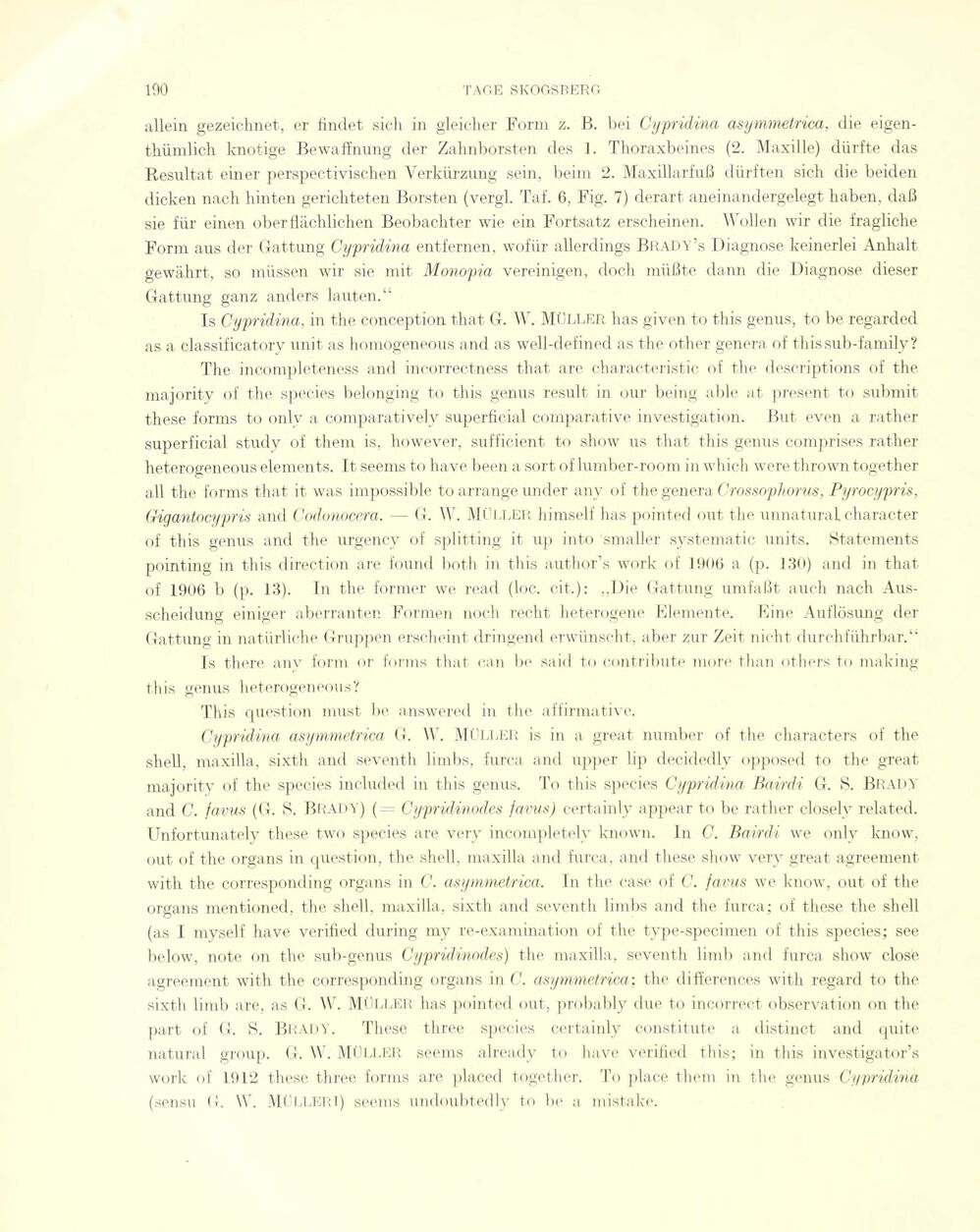
Full resolution (JPEG) - On this page / på denna sida - Sidor ...

<< prev. page << föreg. sida << >> nästa sida >> next page >>
Below is the raw OCR text
from the above scanned image.
Do you see an error? Proofread the page now!
Här nedan syns maskintolkade texten från faksimilbilden ovan.
Ser du något fel? Korrekturläs sidan nu!
This page has never been proofread. / Denna sida har aldrig korrekturlästs.
allein gezeichnet, er findet sich in gleicher Form z. B. bei Cypridina asymmetrica, die
eigentümlich knotige Bewaffnung der Zahnborsten des 1. Thoraxbeines (2. Maxille) dürfte das
Resultat einer perspectivischen Verkürzung sein, beim 2. Maxillarfuß dürften sich die beiden
dicken nach hinten gerichteten Borsten (vergl. Taf. 6, Fig. 7) derart aneinandergelegt haben, daß
sie für einen oberflächlichen Beobachter wie ein Fortsatz erscheinen. Wollen wir die fragliche
Form aus der Gattung Cypridina entfernen, wofür allerdings Brada ’s Diagnose keinerlei Anhalt
gewährt, so müssen wir sie mit Monopia vereinigen, doch müßte dann die Diagnose dieser
Gattung ganz anders lauten.“
Is Cypridina, in the conception that G. W. MÜLLER has given to this genus, to be regarded
as a classificatory unit as homogeneous and as well-defined as the other genera of thissub-family?
The incompleteness and incorrectness that are characteristic of the descriptions of the
majority of the species belonging to this genus result in our being able at present to submit
these forms to only a comparatively superficial comparative investigation. But even a rather
superficial study of them is, however, sufficient to show us that this genus comprises rather
heterogen eous elements. It seems to have been a sort of lumber-room in which were thrown together
all the forms that it was impossible to arrange under any of the genera Crossophorus, Pyrocypris,
Gigantocypris and Codonocera. — G. W. Müller himself has pointed out the unnaturai character
of this genus and the urgency of splitting it up into smaller systematic units. Statements
pointing in this direction are found both in this author’s work of 1906 a (p. 130) and in that
of 1906 b (p. 13). In the former we read (loc. cit.) : „Die Gattung umfaßt auch nach
Ausscheidung einiger aberranten Formen noch recht heterogene Elemente. Eine Auflösung der
Gattung in natürliche Gruppen erscheint dringend erwünscht, aber zur Zeit nicht durchführbar.“
Is there any form or forms that can be said to contribute more than others to making
this genus heterogeneous?
This question must be answered in the affirmative.
Cypridina asymmetrica G. W. MÜLLER is in a great number of the characters of the
shell, maxilla, sixth and seventh limbs, furca and upper lip decidedly opposed to the great
majority of the species included in this genus. To this species Cypridina Bairdi G. S. BRADA
and C. favus (G. S. BRADY) ( - Cypridinodes favus) certainly appear to be rather closelv related.
Unfortunately these two species are very incompletely known. In C. Bairdi we only know,
out of the organs in question, the shell, maxilla and furca, and these show very great agreement
with the corresponding organs in C. asymmetrica. In the case of C. favus we know, out of the
organs mentioned, the shell, maxilla, sixth and seventh limbs and the furca; of these the shell
(as I myself have verified during my re-examination of the type-specimen of this species; see
below, note on the sub-genus Cypridinodes) the maxilla, seventh limb and furca show close
agreement with the corresponding organs in C. asymmetrica-, the differences with regard to the
sixth limb are, as G. W. MÜLLER has pointed out, probably due to incorrect observation on the
part of G. S. Brada. These three species certainly constitute a distinct and quite
natural group. G. W. MÜLLER seems already to have verified this; in this investigator’s
work of 1912 these three forms are placed together. To place them in the genus Cypridina
(sensu G. W. Müller]) seems undoubtedly to be a mistake.
<< prev. page << föreg. sida << >> nästa sida >> next page >>